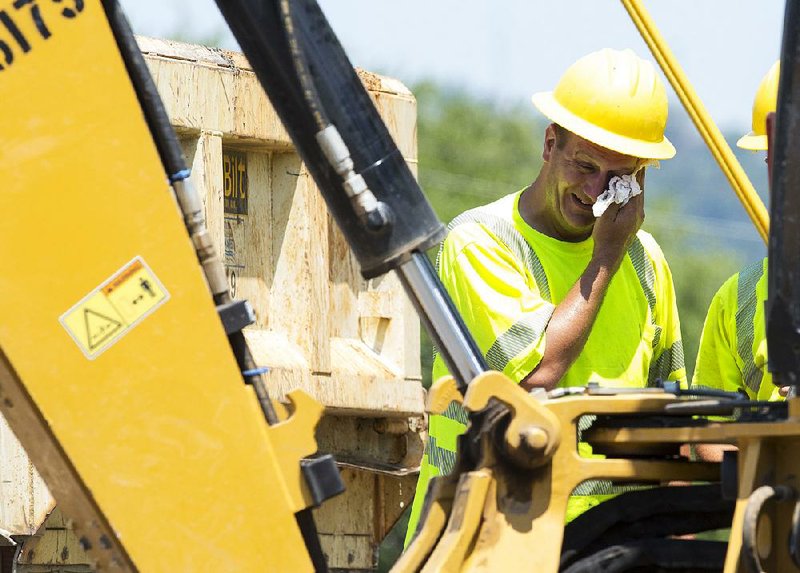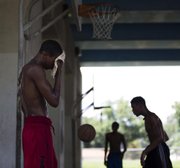Temperatures reached triple digits for the first time this year in Little Rock on Friday and some towns in south Arkansas saw a second day of 100-degree weather as a stalled ridge of high pressure over the state keeps cooler air away.
The capital city recorded 103 degrees as a high mark about 3 p.m. Friday -- the highest temperature recorded in Little Rock so far this year, said Joe Goudsward, a meteorologist with the National Weather Service in North Little Rock.
The heat, coupled with high humidity, made it feel like 113 degrees.
"It's warm," Goudsward said. "And it will be another hot one [today]."
The weather service issued excessive heat warnings for most of the eastern half of the state Thursday. The warnings are given when heat indexes climb above 110 degrees. The heat index is derived when combining air temperature with humidity.
The warnings, which stretched east from Randolph County to Saline County and south to Bradley County, remained in effect until 8 p.m. Friday. The weather service extended a heat advisory through 9 p.m. Sunday, meaning indexes will reach 105-110 degrees.
Temperatures reached 101 degrees Friday in De Queen and Hot Springs and hit 100 in Mena, Mount Ida, Camden, Stuttgart and Texarkana.
The National Weather Service issued heat advisories and warnings for at least 26 states Friday, The Associated Press reported. Heat indexes soared to over 110 degrees as far north as Minneapolis and Chicago, and the District of Columbia reported the mercury hit 100 degrees Friday afternoon.
The cause for the blistering temperatures is what some meteorologists call a "heat dome." The heat dome forms when a high-pressure system develops in the upper atmosphere, causing the air below it to sink and compress because there's more weight on top. That raises temperatures in the lower atmosphere.
This heat dome has formed over the central U.S. and is preventing Canadian jet-stream air from dipping farther south.
The National Oceanic and Atmospheric Administration issued a warning about the heat dome earlier this week. The administration said the high-pressure ridge acted as a "lid" and prevented hot air from escaping.
"The air is forced to sink back to the surface, warming even further on the way," the warning said.
The heat dome also created short-lived thundershowers across Arkansas on Thursday and Friday.
Storms, caused by the rising warm air that collided with weak, cooler air, soaked some areas with brief rain showers. But because of the heat inside the "dome," the system dried quickly and rains stopped, the weather service said.
Farmers are hoping for rain soon, said David Miller, executive director of the U.S. Department of Agriculture's Farm Service Agency in Montgomery County.
"I talked with a farmer who is afraid to cut his hay," Miller said. "He has some now for cattle, but he doesn't know what will happen next. If it stays dry, the hay won't grow.
"He is concerned. It's hot," Miller said, adding, "I've seen better conditions. I'd hate to be the guys working on the highway department. It's hard to breathe outside in this heat."
In Texarkana, where temperatures hit 100 for the second consecutive day Friday, customers of the Circle K convenience store on Interstate 30 were cooling down.
"We're selling a lot of drinks and lots and lots of ice," cashier Abby Jordan said.
Mount Ida Mayor Jo Childress said her car thermometer indicated it was 110 degrees in the Montgomery County town.
"I drove around and it got down to 104," she said.
It rained briefly in Mount Ida on Thursday evening, but only enough to raise the humidity. It remained humid Friday.
"It's like a steam oven," Childress said.
The mayor said she has friends who gave up camping this week because of the heat.
"They can't stand it," she said. "You can't stay outside in this heat. They finally came in. They said sitting in the lake was like sitting in warm bath water."
Despite the heat, the Arkansas Forestry Commission said Friday that no Arkansas counties were under burn bans, and, because of the lack of winds and higher humidity, no part of the state is in any elevated danger for wildfires.
That could change within a week, said Chris Fenimore, a climatologist with the National Centers for Environmental Information in Boulder, Colo.
"Rainfall has been at or below 50 percent of normal in Arkansas," Fenimore said in an email. "Farmers are having to irrigate daily due to the lack of consistent rain and the extreme heat. The current weather pattern suggest that the dryness will continue."
The U.S. Drought Monitor, an agency at the University of Nebraska at Lincoln that issues weekly reports about drought conditions in the U.S., said 44.7 percent of Arkansas was considered to be "abnormally dry" and had a 1- to 2-inch deficit of rainfall over a 30-day period.
Fenimore said he expects drought conditions to worsen in Arkansas when the agency releases its next report Thursday.
Goudsward said the high ridge of pressure showed some signs that it could weaken early next week. He forecast a slight chance of rain each day through Thursday, meaning temperatures should drop a few degrees.
"Rain chances should increase somewhat as the ridge begins breaking down," he said. "We may get better rain chances, but temperatures will still be warm. It's summer."
State Desk on 07/23/2016

